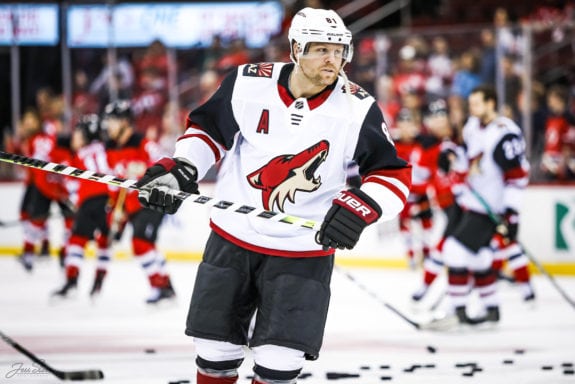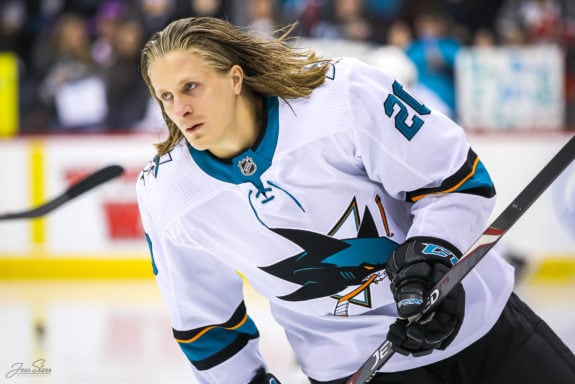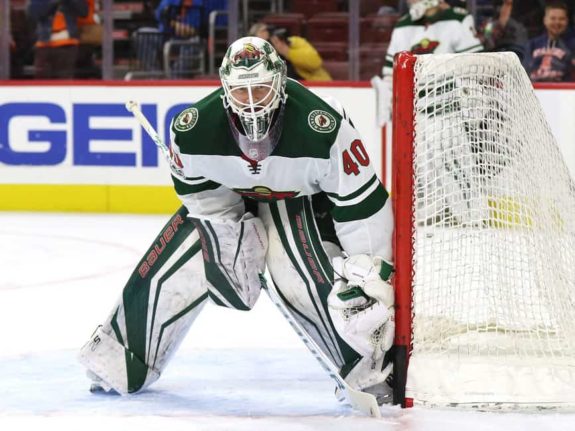The San Jose Sharks just came off their second road series of the year, after drawing their two games with the Arizona Coyotes. This time, they faced the St. Louis Blues, a team who just came from a series with the Colorado Avalanche, where they won the first game but gave up eight goals in the second game.
They lost the first game by a tight score of 5-4, and won the second game by a score of 2-1 in a shootout, with the winner belonging to Tomas Hertl in the fourth round. Here are five takeaways that I saw from the Sharks’ second road series of the season.
Faceoff Percentage Improvements
In the two games against the Coyotes, their faceoff percentage was a staggering 42.5%, after averaging the two faceoff percentages. To help with this deficit, they promoted Fredrik Handemark, who was praised by general manager Doug Wilson for his faceoffs when they signed him to a contract in May.
Coincidentally, despite the loss, their faceoff percentage went up significantly — to 54%, besting the Blues’ 50%. Although, Handemark lost multiple faceoffs in the first period to Blues captain Ryan O’Reilly, and won both faceoffs in the second period against Robert Thomas and Brayden Schenn.

In the case of Wednesday night’s game, Handemark was out of the lineup, and their faceoff percentage went down to 45%, while the Blues had 55%. This is given that a lot of the faceoffs were taken by O’Reilly, who hasn’t had a faceoff percentage below 50% in his career, with the exception of his rookie season with Colorado, where he had a 47.5% rate according to Puck Base.
Second Period Woes
In the past three games, the Sharks have seemingly disappeared when it comes to the second period. In the second game against the Coyotes, they were tied going into the first intermission. Once the second intermission came, they were down 4-2, because of sloppy play during the second period, and allowing goals from Phil Kessel and Jakob Chychrun.

In the first game vs the Blues, it was deja vu. They were up 2-0 going into the first intermission. Suddenly, despite a goal from Brent Burns, the Sharks allowed four goals, two of them from Justin Faulk, putting them down a goal going into the third.
The second game was better, but they still gave up the first goal instead of scoring first. That goal was scored by Brayden Schenn, but Marcus Sorensen equalized not too long later, and they didn’t give up more.

Despite the improvements, there is still room for growth in this area going into the rest of the season. Playing a whole 60-minute game is key to getting wins, and the sloppy mid frames are the Achilles heel inhibiting those wins.
Leonard, Knyzhov Still Doing Great Work
John Leonard, the Sharks’ sixth-round pick of the 2018 NHL Draft, was making a great case why he should be on the team’s roster during training camp. Now, he is proving why he should stay on the roster, and frankly, I love the way he is playing right now.
The reason why is because of one simple thing. When his line is on the ice for a shift, he is constantly throwing pucks at the net for potential chances for either himself to get a goal, or to get an assist from his fellow linemates. Two of those chances in his first NHL game led to two assists, his first NHL points.
Unfortunately, the game Wednesday saw Leonard only get one shot on goal, possibly because of his demotion to the third line, and being on the ice for a total of just under 12 minutes, which was seventh lowest on the team.
Nikolai Knyzhov is another young player signed to a contract in July of 2019, and he made his debut late last season. He made a case for himself being on the opening night roster and is looking to keeping his role as part of the Shark’s third defensive pairing.
The good that I am seeing out of him so far is that he is playing aggressive defense, but not overly aggressive to get himself penalized. He keeps that mentality despite being on the ice for the opposing team’s goals, earning him a minus-2. Hopefully, that aggression leads to some scoring chances for the young defenseman, as he only has three total shots on the year so far.
It is also helping that he is getting paired with veteran defenseman Radim Simek. It gives someone like Knyzhov a model for his own game.
Goalies Can’t Bail You Out of Everything
During the first game against the Blues, I found myself repeating the same thing as the game went on — the goalies can’t bail you out of every situation. This is because most of Devan Dubnyk’s saves in the 5-4 loss came off of errors in the Sharks’ zone. This is proven by the team’s five total giveaways in the game to the Blues’ one total giveaway.

The second game saw significant improvement, with the Sharks only having one giveaway through the entire game from Burns in the first period. It also helped that Martin Jones saved 23 of 24 shots in his third start of the season.
Penalty Kill Still Shining
It’s weird that despite the Sharks’ shortcomings through the seasons, their penalty kill still ranks atop the entire league. Even at three games played this season, the Sharks’ penalty kill is at 80%. Last season, despite it being cut short due to the pandemic, their penalty kill rate was still number one at 88.5%.
In a 2019 article from the SF Chronicle, Ross Mckeon cites defenseman Erik Karlsson gives a reason as to why their penalty kill ranks so highly.
“We have good penalty killers who are smart players, not necessarily the biggest or the toughest,” Sharks defenseman Erik Karlsson said. “But think the game the right way.”
From ‘When it comes to killing penalties, Sharks are in class by themselves’, San Francisco Chronicle, 12/6/2019
In the case of the first game in the Blues series, the Sharks were faced with three power plays throughout the entire game, and held them to no goals during all of them. In the second game, they were faced with seven power plays. They were successful in killing all of them and not allowing goals.
These are five takeaways from the Sharks’ series against the Blues. It’s safe to say that there is a mixed bag of good and bad from the team in this series. Hopefully, in their next series against the Minnesota Wild that starts on Friday, they can improve or continue on these trends.